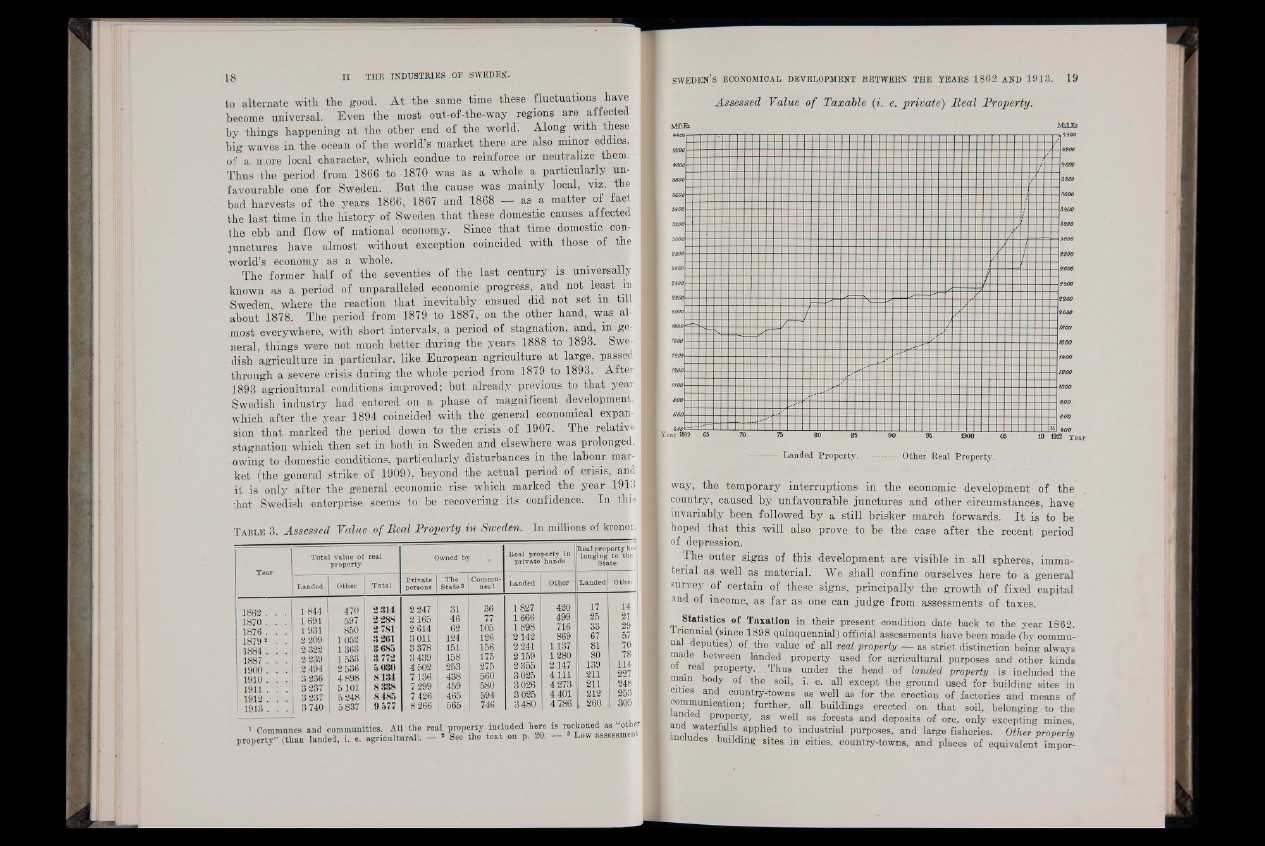
to alternate with the good. At the same time these fluctuations have
become universal. Even the most out-of-the-way regions are affected
by things happening at the other end of the world. Along with these
big waves in the ocean of the world’s market there are also minor eddies,
of a more local character, which condue to reinforce or neutralize them.
Thus the period from 1866 to 1870 was as a whole a particularly unfavourable
one for Sweden. But the cause was mainly local, viz. the
bad harvests of the years 1866, 1867 and 1868 — as a matter of fact
the last time in the history of Sweden that these domestic causes affected
(he ebb and flow of national economy. Since that time domestic conjunctures
have almost without exception coincided with those of the
world’s economy as a whole.
The former half of the seventies of the last century is universally
known as a period of unparalleled economic progress, and not least in
Sweden, where the reaction that inevitably ensued did not set in till
about 1878. The period from 1879 to 1887, on the other hand, was almost
everywhere, with short intervals, a period of stagnation, and, in general,
things were not much better during the years 1888 to 1893. Swedish
agriculture in particular, like European agriculture at large, passed
through a severe crisis during the whole period from 1879 to 1893. After
1893 agricultural conditions improved; but already previous to that year
Swedish industry had entered on a phase of magnificent development,
which after the year 1894 coincided with the general economical expansion
that marked the period down to the crisis of 1907. The relative
stagnation which then set in both in Sweden and elsewhere was prolonged,
owing to domestic conditions, particularly disturbances in the labour market
(the general strike of 1909), beyond the actual period of crisis, and
it is only after the general economic rise which marked the year 1913
;hat Swedish enterprise seems to be recovering its confidence.. In this
T able 3. Assessed Value of Beal Property in Sweden. In millions of kronor.
1862 .
1870 .
1876 .
1879 s
1884 .
1887 .
1900 .
1910 .
1911 .
1912 .
1913 .
Totftl value, oi real
property
1844
1691
1931
2 209
2 322
2 239
2 494
3 236
3 237
3 237
3740
470
597
850
1 052
1363
1533
2 536
4 898
5101
5 248
5837
2314
2 288
2 781
3261
3685
3 772
5 030
8134
8338
8485
9577
Owned by
Private
persons
2 247
2165
2 614
3011
3 378
3 439
4 502
7136
7 299
7 426
8266
The Comme-
State 3 nes 1
■ 36
77
li)5
126
156
175
275
560
580
594
746
Beal property in
private hands
Real property be
longing to the
State
1827
1666
1898
2142
2 241
2159
2 355
3 025
3 026
3 025
3480
420
499
716
869
1137
1280
2147
4111
4 273
4 401
4 786
"Landed ' Othe;
114
227
248
253
305
1 Communes and communities. All the real property included here is reckoned as “other
property” (than landed, i. e. agricultural). - s See the text on p. 20. - = Low a s s e s s m e n t
Assessed Value o f Taxable (i. e. private) Beal Property.
— Landed Property. ........... Other Real Property.
way, the temporary interruptions in the economic development of the
country, caused by unfavourable junctures and other circumstances, have
invariably been followed by a still brisker march forwards. It is to be
hoped that this will also prove to be the case after the recent period
of depression.
The outer signs of this development are visible in all spheres, immaterial
as well as material. We shall confine ourselves here to a general
survey of certain of these signs, principally the growth of fixed capital
and of income, as far as one can judge from assessments of taxes.
Statistics of Taxation in their present condition date back to the year 1862.
triennial (since 1898 quinquennial) official assessments have been made (by communal
deputies) of the value of all real property — as strict distinction being always
made between landed property used for agricultural purposes and other kinds
ol real property. Thus under the head of landed property is included the
mam body of the soil, i. e. all except the ground used for building sites in
cities and eountry-towns as well as for the erection of factories and means of
communication; further, all buildings erected on that soil, belonging to the
landed property, as well as forests and deposits of ore, only excepting mines,
and waterfalls applied to industrial purposes, and large fisheries. Other property
nciudes building sites in cities, eountry-towns, and places of equivalent impor